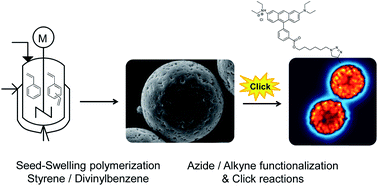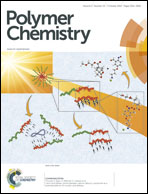Macroporous uniform azide- and alkyne-functional polymer microspheres with tuneable surface area: synthesis, in-depth characterization and click-modification†
Abstract
A series of uniform, macroporous poly(styrene-co-divinylbenzene) microspheres with diameters ranging from 6.6 ± 0.6 to 8.6 ± 0.2 μm was prepared in a multistep procedure involving precipitation polymerization synthesis of polystyrene seed particles, swelling of seed particles with plasticiser and porogen, and polymerization of styrene–divinylbenzene (S–DVB) inside the seed particles. Particles prepared with varying DVB feed ratios had comparable diameters (as evidenced by scanning electron microscopy) with specific surface areas increasing with DVB content from 11 to 467 m2 g−1 (measured by nitrogen adsorption). Residual double bonds were converted into azide functionality (through HBr addition and bromo-azide substitution) or alkyne functionality (Br2 addition followed by double elimination) which allowed for CuAAC-click chemistry conjugation with reagents carrying the respective complimentary alkyne or azide functional groups including the fluorescent dye derivatives 7-nitro-4-(prop-2-ynylamino)benzofuran (NBD-alkyne) and Rhodamine B hexylazide synthesised for this purpose. Efficiency of chemical transformations was determined using a combination of CHN and IC elemental analyses, solid state NMR spectroscopy, FT-IR spectroscopy, Raman spectroscopy, and confocal scanning fluorescence microscopy. Although the respective second steps in each modification route (substitution and elimination) suffered from lower yields (∼35%), porous particles with azide loadings of up to 0.71 mmol g−1 and alkyne loadings of up to 0.78 mmol g−1 were prepared. Confocal laser scanning microscopy on Rhodamine B-labelled microspheres indicated functionalization throughout the particles featuring a core–shell structure with higher functionalization in the outer layer of particles. Results are expected to contribute to the development of advanced, well-defined, macroporous particles with high, chemically accessible surface areas.


 Please wait while we load your content...
Please wait while we load your content...